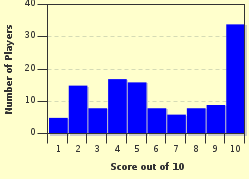Quiz Answer Key and Fun Facts
1. The UK has only two native toads, the natterjack and the common toad. However several others have been introduced. One of these species was widely used in the 1940's in pregnancy testing. What species is it?
2. This toad species was introduced to Bedfordshire in 1898, and is now spread around central England, and as far north as Yorkshire. Its call is likened to the sound of a bell, and its tadpoles can grow to almost twice the length of the adult. What is it called?
3. The next introduced toad species has been found breeding in south London and in Devon. It can be identified by the colourful underside and heart-shaped pupils. What is it called?
4. There are three native newts in the UK, though at least two others have been introduced. One species looks very similar to the native common newt, but can be distinguished by the lack of spots on the throat and underbelly. What is this newt called?
5. This introduced newt species is large, up to 15cm, and has a ridge down the back. It can interbreed with the UK's rarest newt, the great crested newt, and as such is a threat to the gene pool. What is the newt called?
6. This large frog was available in the pet trade in Europe until being banned in 1997 because of concerns it would breed and have a negative impact on native species. Despite this at least two populations were discovered breeding in southern England, and measures were put in place to attempt to exterminate them. What frog is this?
7. The status of this next amphibian is complicated. Officially it only exists in the UK as an introduced species, which is almost certainly true. However it is now thought that a population that lived in the New Forest and only became extinct in the late 70's may have actually been a native species. Any other populations are introductions from Europe, but what species of frog is this?
8. The next frog is a frog that once lived in the UK, but became extinct in 1995. This frog species was then reintroduced with stock from Sweden. However this species has two different forms, a brown northern race which is the type that once existed in the UK and is also found in Sweden, and a green race that lives in countries south of the UK. The green form has also been introduced to the UK, and as such poses a threat to the brown form that is becoming re-established. What type of frog is this?
9. This next frog has never been found naturally in the wild in the UK. However it has been introduced here, with the earliest introduction dating back to roughly 1884. This frog can grow up to 15cm long and has an interesting relationship with the frog mentioned in the previous question. What kind of frog is this?
10. The last frog in this quiz is a green coloured frog like the pool frog and marsh frog, and is intermediate in size and vocalisation between them. It is in fact a hybrid between the two species, but this hybrid is special in that it can propagate more of the same hybrid. What is it called?
Source: Author
Benesesso
This quiz was reviewed by FunTrivia editor
crisw before going online.
Any errors found in FunTrivia content are routinely corrected through our feedback system.

